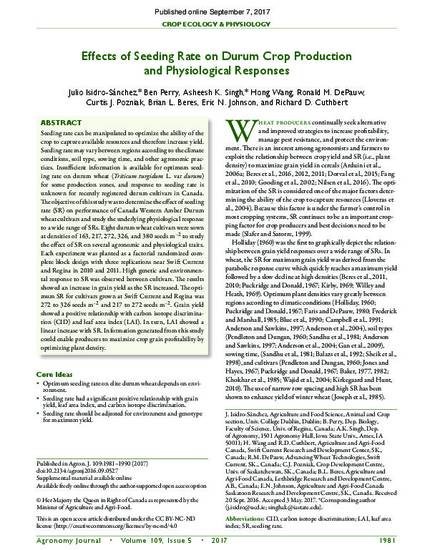
Seeding rate can be manipulated to optimize the ability of the crop to capture available resources and therefore increase yield. Seeding rate may vary between regions according to the climate conditions, soil type, sowing time, and other agronomic practices. Insufficient information is available for optimum seeding rate on durum wheat (Triticum turgidum L. var durum) for some production zones, and response to seeding rate is unknown for recently registered durum cultivars in Canada. The objective of this study was to determine the effect of seeding rate (SR) on performance of Canada Western Amber Durum wheat cultivars and study the underlying physiological response to a wide range of SRs. Eight durum wheat cultivars were sown at densities of 163, 217, 272, 326, and 380 seeds m–2 to study the effect of SR on several agronomic and physiological traits. Each experiment was planted as a factorial randomized complete block design with three replications near Swift Current and Regina in 2010 and 2011. High genetic and environmental response to SR was observed between cultivars. The results showed an increase in grain yield as the SR increased. The optimum SR for cultivars grown at Swift Current and Regina was 272 to 326 seeds m–2 and 217 to 272 seeds m–2. Grain yield showed a positive relationship with carbon isotope discrimination (CID) and leaf area index (LAI). In turn, LAI showed a linear increase with SR. Information generated from this study could enable producers to maximize crop grain profitability by optimizing plant density.
Available at: http://works.bepress.com/asheesh-singh/26/

This article is published as Isidro-Sánchez, Julio, Ben Perry, Asheesh K. Singh, Hong Wang, Ronald M. DePauw, Curtis J. Pozniak, Brian L. Beres, Eric N. Johnson, and Richard D. Cuthbert. "Effects of Seeding Rate on Durum Crop Production and Physiological Responses." Agronomy Journal 109, no. 5 (2017): 1981-1990. doi: 10.2134/agronj2016.09.0527. Posted with permission.